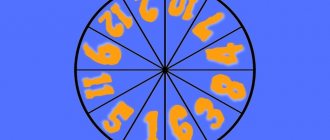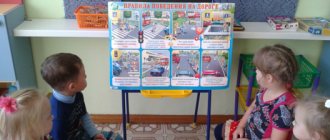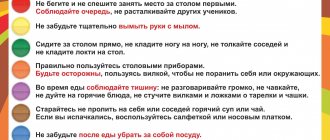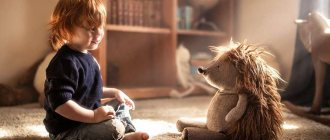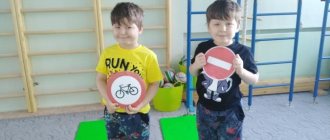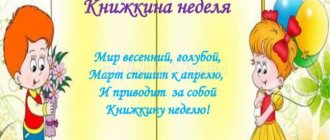Be careful, insects!
Goal: to develop in children an understanding of how to behave when encountering insects.
Materials: pictures depicting various insects.
The teacher shows the children pictures of insects. For example, ladybug, wasp, rhinoceros beetle and mosquito. The teacher asks:
- Are you familiar with these insects?
- What harm can they cause?
- Is there any way to protect yourself from them?
- What to do if you are bitten?
If the kids could not answer all the questions, the teacher prompts.
Then the teacher recites the poem, simultaneously showing the movements:
I was stung by a bee (He shows with his finger how a bee stings, and the children repeat after him) I shouted: “How could you!” (Everyone shouts together, “How could you?”) The bee responds: “How could you pick my favorite flower? (Shows how he picks a flower) After all, I really needed it: (Everyone buzzes together like bees) I was saving it for dinner!” (Show how a bee eats)
Then the teacher discusses with the children why the bee stung and how it could have been avoided. It is important to convey to children the idea that insects usually do not attack if they are not disturbed.
To reinforce the topic, the teacher conducts a quick survey with the children:
- What to do if a bee or wasp is flying near you? (don't wave your arms)
- What to do if you step on an anthill? (quickly leave this place and shake off the ants)
- What to do if you see a beetle? (pass by)
Week "Safe behavior in nature"
Natalia Arzabuzova
Week "Safe behavior in nature"
Day of the week
Mode: Joint activity of an adult and a child
Group, subgroup
Individual educational activities in special moments Creation of an educational environment for independent activities of children
Monday 10/22/2018 Morning Conversation: “What is the natural ”
Goal: Contribute to the formation of knowledge about the
natural . D / game “Be careful in
nature ” Purpose: to consolidate children’s ideas about dangerous situations in
nature , teach the rules of safe behavior , develop memory, and cultivate a sympathetic attitude towards the victim. Morning exercises. Goal: improve skills in basic types of movements; form correct posture. Work on developing fine and gross motor skills “Trace the tomato with dots
.
With Sofia, Polina, Kostya. When dressing for a walk, fix the names of clothes, shoes, hats - develop fine motor skills, cultivate an attentive attitude towards peers. poster “Rules
of behavior in nature ” .
D/game “ Safety in nature ”
OOD 1. Physical culture (see plan)
2. Familiarization with the objective and social world. “It’s good in our garden”
. Teach children to navigate some nursery rooms. cultivate a friendly attitude and respect for employees. O. V. Dybina, from 30
Walk Walking map No. 14. “Birds fly away to warmer lands”
.Goals: continue to acquaint children with
natural phenomena in autumn , the life of plants and animals (flight of birds)
; promote the development of observation, curiosity, horizons, and search and research skills; cultivate a love for birds.
Individual. PHYSICAL work. Goal: To teach children to roll a ball in front of them and catch up with it. (Tanya, Vasilisa, Maxim)
Evening Health-improving gymnastics after sleep Goal: to form the need for daily physical activity.
Analysis of the situation “If you are bitten by a mosquito”
Goal: To establish the rules for handling insects. d/game “Collect a plant”
.Goal: to form children’s ideas about the structure of plants, its parts and their significance for plant life.
Yana, Pavel, Miroslav. Situational conversation “Sunny bunnies”
. Goal: to develop a sense of community with other children. Improve your ability to participate in a general conversation. Pictures depicting the main parts of plants.
Evening walk Children play independently in the area. Goal: continue to teach children to play independently; interact in a team; give in to each other; share toys; cultivate interest in children's games. Generalization of ideas about typical spring phenomena in inanimate nature .
P/i “Bird and Cat”
,
“Birds and a car”
- exercise running, the ability to navigate in space, endurance.
Day of the week
Mode: Joint activity of an adult and a child
Group, subgroup
Individual educational activities in special moments Creation of an educational environment for independent activities of children
Tuesday 10/23/2018. Morning Conversation “How sand can become dangerous”
Goal: show the child games with sand and warn him that playing with it
is unsafe : you need to be careful and make sure that sand does not get into your eyes, mouth, nose, clothes, head. Situational conversation “Why you can’t pick inedible mushrooms and berries”
Morning exercises. Goal: improve skills in basic types of movements;
form correct posture. D/I “How many beetles are there”
Develop the ability to distinguish between one and many. (Maxim, Makar, Nastya)
Continue to teach children to take off their clothes before going to bed and hang them neatly on their high chair, and remember their clothes.
Pictures of insects.
OOD 1. FEMP.Goals: to improve the ability to compose a group of objects from individual objects and to single out one object from the group, to denote the totality with the words one, many, none; continue to learn to distinguish and name a circle, examine it tactile-motorly and compare circles by size: large, small. Pomoraeva, 15.
2. Physical education (see plan)
.
Walk Walking map No. 15. “How trees prepare to meet winter”
.Goals: continue to introduce children to the trees of their immediate environment; fix the names of coniferous and deciduous trees; tell how they prepare to meet winter, that they are a habitat for animals and birds; promote the development of observation, curiosity, horizons, and search and research skills; cultivate a love for plants.
Ind. work with Sasha, Maxim, Artem. Practice balance.
Evening Health-improving gymnastics after sleep. Goal: to form the need for daily physical activity. Research activities. “Here it is, shifting sand”
Purpose: to introduce the properties of sand.
D/I (mosaic) “Fold the bee” (team work)
Develop constructive abilities, consolidate knowledge of geometric shapes. Playing with sand.
Develop independent play activities; imagination, fantasy. Pavel, Veronica.
Situational conversations about the rules of cultural behavior at the table during dinner (chew with your mouth closed, use a napkin, develop the ability to properly use a spoon, napkin) Sand, molds, spatula
Evening walk Observing the clouds. Purpose: to develop children's powers of observation, imagination, and fantasy; develop skills in writing a descriptive story.
P/i "Birds and Chicks"
Goal: to develop dexterity, the ability to navigate in space.
Day of the week
Mode: Joint activity of an adult and a child
Group, subgroup
Individual educational activities in special moments Creation of an educational environment for independent activities of children
Wednesday 10/24/2018. Morning Conversation “We are young friends of nature ”
Goal: To encourage emotional responsiveness to the aesthetic side of the world around us.
Didactic game “You can - you can’t”
Goal: To form basic ideas about ways of interacting with animals and plants, about the rules of
behavior in nature .
Morning exercises. Goal: improve skills in basic types of movements; form correct posture. Learning finger exercises “Mushrooms”
Goal: development of fine motor skills of the hands.
Cultivate neatness, respect for personal belongings, the belongings of a friend, and a culture of behavior in the locker room .
OOD 1. Music (according to the music director’s plan)
2. Hood. esthete. development. Modeling. “A gift for your favorite puppy (kitten)
. Form imaginative perception and imaginative ideas, develop imagination. Teach children to use acquired skills and abilities in modeling. T. S. Komarova 57
Walk
Walking map No. 16. “Like thin ice”
.Goals: continue to introduce children to
natural (light frost in the morning, the sun still warms in the afternoon)
; promote the development of observation, curiosity, horizons, and search and research skills.
Instructions for strengthening ATS: practice jumping on both legs while moving forward. Anya, Veronica, Alisa Gr.
Evening Health-improving gymnastics after sleep
Goal: to form the need for daily physical activity. Presentation “Poisonous mushrooms and berries”
Target. Expand children's horizons. Enrich knowledge.
D/ game “Put the fungus in your box”
Target.
Learn to recognize poisonous and edible mushrooms. Indian modeling workshop with Artem, Roma, Dinar “Treat for dolls”
Purpose: to teach children to roll out lumps of plasticine with straight movements, to connect the ends of the resulting stick.
“What we collected from the garden”
Purpose: To teach to recognize vegetables and develop speech.
Insert pictures “Poisonous mushrooms and plants”
Purpose: To develop basic
safety
Evening walk
Observation "Evening Shadows"
.Goal: To give ideas about the appearance of shadows, to update ideas about the properties of light. Develop speech, thinking, imagination, curiosity, interest in the artistic word.
Communication games: “Who can name the most?”
,
"What happens if?"
Goal: to develop coherent speech, the ability to logically express one’s thoughts.
Day of the week
Mode: Joint activity of an adult and a child
Group, subgroup
Individual educational activities in special moments Creation of an educational environment for independent activities of children
Thursday 25.10.2018. Morning Conversation “Cats can be dangerous too”
Goal: Expanding understanding of the rules
of safe communication with animals, domestic and wild. Consideration of a series of plot pictures “What is good and what is bad” Purpose: To teach children to distinguish good behavior from bad . Pay attention to the fact that good behavior brings joy and health to both yourself and the people around you. Morning exercises. Goal: improve skills in basic types of movements; form correct posture. Ind. Job. With Yana, Karina, Pasha. Games with sounds “Guess what rustles, what makes noise”
Purpose: to develop auditory perception and attention.
Cultivate a desire to take care of your health by washing your neck, face, hands with cool water (during the day)
Series of pictures “What is good and what is bad”
.
OOD 1. Speech development. Reading of A. Blok’s poem “Bunny”
.
Memorizing verse. A. Pleshcheeva “Autumn has come...”
Goals: to help children remember the verse.
A. Pleshcheeva “Autumn has come...”
.
When perceived, verse. A. Block “Bunny”
to evoke sympathy for the bunny. Gerbova, 40
2. Physical education (see plan)
Walk Walking map No. 17 “Playing with shadows”
natural phenomena (the reflection of the sun in glass or a shadow on the ground)
; promote the development of observation, curiosity, horizons, and search and research skills.
Ind slave with Lera, Miroslav - exercise endurance running.
Evening Health-improving gymnastics after sleep. Goal: to form the need for daily physical activity.
Word games “Guess the description”
Goal: learn to guess the word from the description.
Develop attention, memory, speech, vocabulary of children. Teacher’s story “How to dress for the forest”
Purpose: To expand children’s knowledge on the topic.
Individual work with Anya, Roma, Alisa Ger. Did game "Colors"
- learn to find pictures of the desired color and distribute them into groups.
To develop in children the ability to find activities of interest, play with other children, and avoid conflict situations. d/game “Colors”
Evening walk Observation of the starry sky. Goal: to develop curiosity, attention, the ability to find beauty in the surrounding world.
Outdoor games “On a level path”
,
“Catch a mosquito”
Purpose: to teach children to combine push-off with a wave of their arms when jumping, and to maintain balance when landing.
Day of the week
Mode: Joint activity of an adult and a child
Group, subgroup
Individual educational activities in special moments Creation of an educational environment for independent activities of children
Friday 26.10. 2022 Morning Teacher's story “What to do if you get lost in the forest”
.Goal: Instill the basics
of safety , rules of conduct in the forest . Examination of medications in the first aid kit and demonstration of first aid for cuts and insect bites. Goal: to develop first aid skills. Morning exercises. Goal: improve skills in basic types of movements; form correct posture. Ind work on speech development with Nastya, Seryozha. Learning the song “Little Hedgehog”
. Goal: to develop speech and auditory perception.
d/i “What would happen if.”
Goal: solving situations, life safety, development of speech, thinking, imagination.
Staging of the nursery rhyme "Cat's House"
.
Bringing a first aid kit with bandages, cotton wool, and medicine bottles into the center of role-playing games.
OOD 1. Art. - esthete. development. Drawing. "Blow up, bubble"
. Teach children to convey images of outdoor play in drawings. Strengthen the ability to draw round objects of different sizes. Develop the ability to paint with paints and hold a brush correctly. T. S. Komarova s. 56
2. Musical lesson. (according to the music director’s plan)
.
Walk Walking map No. 18 “Gloomy sky”
.Goals: continue to acquaint children with
natural phenomena in late autumn (night frosts, snow, cloudy weather)
; learn to establish cause-and-effect relationships; promote the development of observation, curiosity, horizons, and search and research skills.
Ind slave in physical training with Pasha, Maxim, Lera “One, Two, Tri-run”
- learn to act on the teacher’s signal.
Evening Final entertainment “ Safety in nature ”
.Goal: To develop attention, memory, thinking when solving problem situations, the instinct of self-preservation.
Articulation gymnastics with Egor, Sasha “Horse”
. Goal: development of the articulatory apparatus. To form in children a conscious attitude towards order, a desire to maintain order in the environment.
Evening walk Observing the clouds. Purpose: to develop children's powers of observation, imagination, and fantasy; develop skills in writing a descriptive story.
Word game on life safety. “What to do if you get lost”
Goal: to develop speech, thinking, imagination.
